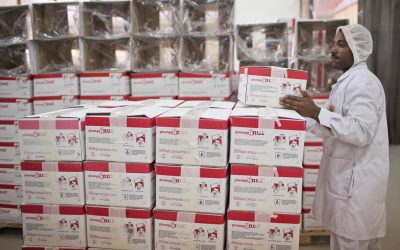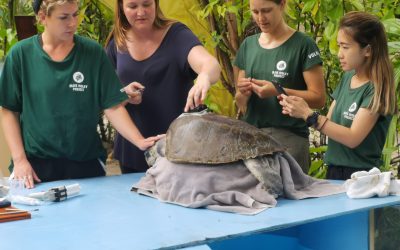Arribada recently returned from field sites in Assam, India where we tested the image quality and detection abilities of low-cost thermal sensors for detecting elephants in conflict areas. Arribada is working on these thermal cameras as a winner of the WWF and WILDLABS Human Wildlife Conflict Tech Challenge. During these initial trials, we used a basic camera-trap set up to understand power consumption and computer processing needs in preparation for a final thermal camera design. We hope to build an early animal alert system to warn communities when dangerous animals have entered a community. The system is designed to use thermal sensors for better detection in low or no light. Eventually, we want to train a computer algorithm to automatically recognize the thermal image of a target animal and send an alert. We’re specifically working on polar bear and elephant detection now but hope our system can help with all types of animals. You can read our previous progress reports on WILDLABS.net, including the field test of different thermal sensors for polar bears in arctic Greenland.
As a quick re-cap, we chose a FLIR Lepton 2.5 shuttered microbolometer sensor with 80×60 pixel resolution for work in climates above -10°C, such as India and other elephant habitats. After reviewing various thermopile and microbolometer thermal sensors, we chose this microbolometer because we believe it will give us the necessary image quality for a computer to identify a target animal at the lowest cost. While higher resolution thermal sensors will generate a better image, their cost is significantly higher, making them more difficult for lower economic communities to afford.
The India test sites are serving as locations to field test the thermal sensors and collect images of elephants and other animals needed to train a recognition algorithm. During this first trial, we wanted to investigate functionality of the camera, such as the image quality FLIR Lepton 2.5 sensor in field climate conditions, the power consumption and the PIR sensor trigger. For this prototype camera, the FLIR Lepton 2.5 was always on, but no images would be saved unless the PIR sensor sensed movement. Getting false triggers was concern, as sometimes changing temperature conditions are enough to mimic the change in IR radiation caused by something warm moving past the sensor. Branches or other vegetation blowing in the wind in front of the camera can also cause false triggers. This vegetation could block elephants from view and impede recognition. Understanding the environment at conflict sites in India is also very important. Contrasting temperatures of paved roads, rivers, dirt roads and grass present in India vary in temperature under the sun, which could make an elephant more difficult to spot. We also wanted to get a sense of the scale of the areas needing to be monitored.
We travelled to Assam, India during November 2018, the elephant conflict season. During the winter months, elephants come down from the northern mountains and journey south to the Brahmaputra river, raiding rice paddies fields and tea plantation worker’s homes along the way, as illustrated in the image below.
The WWF India team in Tezpur scouted out several sites for consideration before Arribada’s arrival. These included a tea plantation with adjacent rice paddies eaten by wild elephants, two locations in the protected Kaziranga National Park and an elephant camp. Priorities for choosing the deployment sites were frequency of use by elephants, security from theft and ease of access. We deployed two cameras, one at the edge of a tea plantation and the other at the elephant camp. Both sites were secure and gave both a wild site and a more controlled site where we knew we would collect images of elephants.
These cameras remained in the field after Arribada’s departure under the care of WWF India. The WWF India team will be collecting images from the cameras, charging the batteries, performing general maintenance and reporting back on general functionality of the cameras with improvement suggestions. With their work, these sites in India can serve not only as data collection sites, but true development sites for the cameras.
Site Challenges
The biggest site challenges in India were related to their size and amount of vegetation. At some sites, multiple pathways were used by elephants. Since not all could be covered with cameras, we chose paths used most frequently. Many adjustments were made to the placement of the camera to ensure capture of the whole height of the elephant at multiple distances and maximize the amount of time an elephant would be walking through the camera’s field of view. We also positioned the cameras so little vegetation could block the elephants from view. Sites with more shade were considered more favorable than sites in full sun. During zoo testing, we noticed that even dirt grounds could heat up in the sun enough to be a similar temperature to an elephant, causing the elephant to blend into the background and be unrecognizable.
Results
At the time of this writing, we’ve received images back from the camera at the elephant camp only, although the second camera is up and functioning. As seen in the picture below, the camera at the elephant camp is facing a dirt path down which the elephants walk to bath in the river seen in the background.
Captured images from the elephant camp are clear, relatively free of noise and elephants are recognizable by humans at multiple distances. The next images are from the thermal camera and show elephants relatively close to the camera, about 5 and 7 meters. In the left image, the elephant is close enough that the camera sees detailed differences in its skin temperature and the relative coolness of its ears. The right image doesn’t show as much temperature variation in the elephant, but its shape is clearly visible, standing out warmer than the background. The mahout riding the elephant is also distinguishable. It is interesting to note that although this scene is in full sun, as can be seen in the camp photo, the elephant still stands out as warmer than its surroundings. This could be because the surroundings are mostly grass and water which stay cooler in the sun than dirt, concrete pavement or metal. Although the optical photo of the site shows a dirt path, the thermal camera’s field of view is narrower and doesn’t include the dirt path. Had the dirt path been in the camera frame, it may have been a similar temperature to the elephant’s feet. It could also be that full sunlight is not always a problem and needs to be considered on a site by site basis.
The thermal images below each show an elephant between 10 and 15 meters away from the thermal sensor, standing on the grassy river bank. In each image, the elephant is clearly visible and identifiable by its side profile showing all four legs and its trunk. The left image even shows variation in the elephant’s skin temperature at the 10 to 15 meter distance.
We have discovered some problems related to the camera’s PIR trigger and image saving. The field of view (FOV) of the PIR sensor is 270°, but the thermal sensor’s FOV is 63.5° x 50°. This means things moving to the sides of the camera trigger the PIR to begin saving pictures although nothing may be in the thermal sensor’s FOV (Left image below). While this is not exactly a false trigger, it uses camera power and memory capturing blank images. The amount of time needed to save an image was also a problem. Each thermal image is written to memory individually and during this time, no other thermal images are captured. Taking too much time to save an image means we miss times when the elephant is moving past the camera. Because image saving is being triggered early by the PIR sensor’s wide FOV and then paused while the image is being written to memory, most of our images only show the front and back half of an elephant moving past the frame (center and right images below). This misses the shot of the whole elephant we need to train an algorithm to recognize an elephant’s full shape. We tracked the issue to a library which handles automounting the USB on which pictures are saved and believe we can correct the problem.
System power with the 27000 mAh battery is around four days. We did not attach solar panels to our prototype cameras, but we would like to incorporate them into a final design so the cameras can remain in the field for long periods of time without needing to charge the battery.
Overall, we are very happy with the results from our trial in India and think it will be an excellent site for testing and further development. The WWF India team will provide invaluable reports on the functionality of the cameras and can even make and suggest modifications that can be incorporated into a final design. We are looking forward receiving more images from the India sites in the future.



interesting post, Thanks for sharing.
We are Techneed Pvt Ltd, IOT company from Sri lanka. Recently, we got a requirement for a solution of elephant tracking system.So, we are interested with this product. can we contact you to aware of this product?
Many thanks for getting in touch Erangika. We’ve contacted you directly with more information.
Kind regards,
Arribada